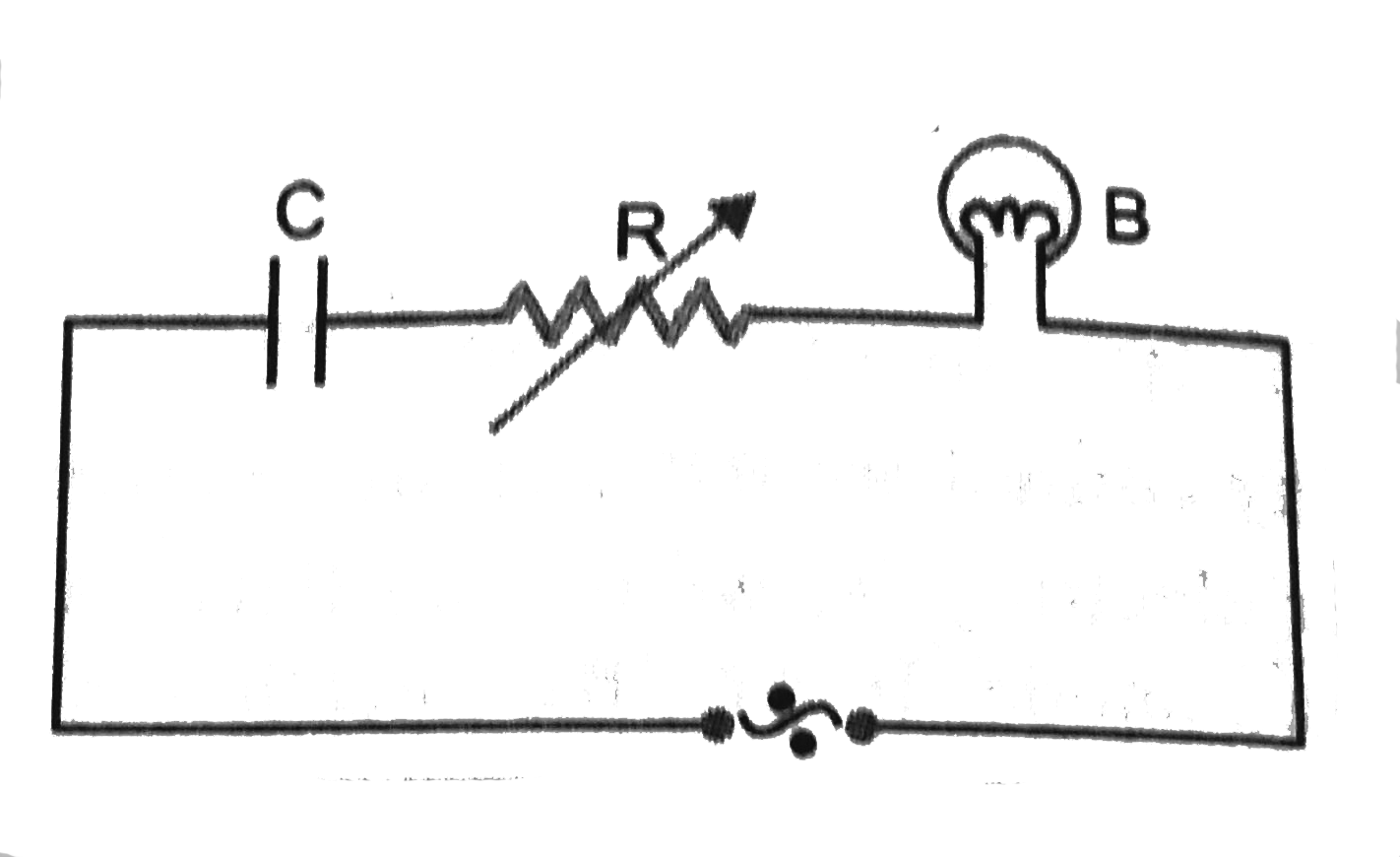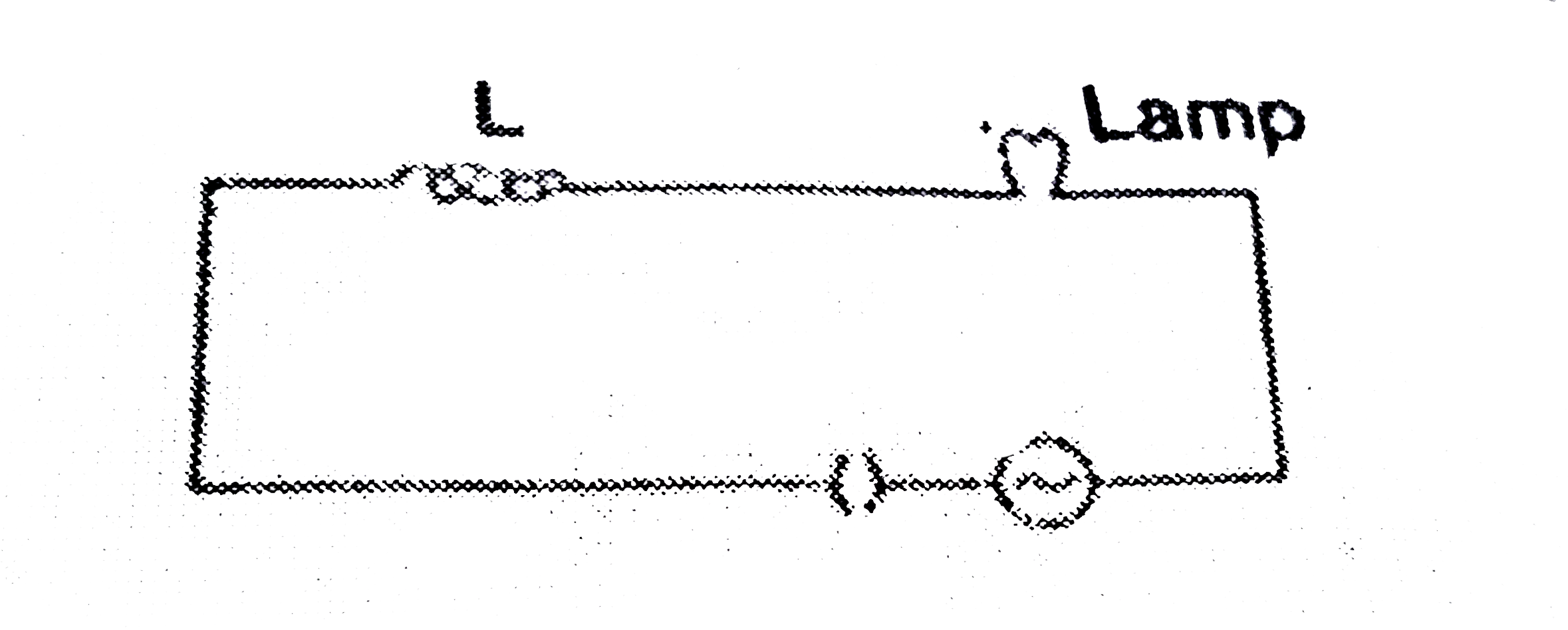An electric lamp having coil of negligible inductance connected in series with a capacitor and an a.c. source is glowing with certain brightness, Fig. How does the brightness of the lamp change on reducing (i) capacitance (ii) frequency
To solve the problem, we need to analyze how the brightness of the lamp changes when the capacitance and frequency of the AC circuit are altered. The brightness of the lamp is related to the current flowing through it, which in turn is influenced by the impedance of the circuit.
1. Understanding the Circuit:
- The circuit consists of a lamp (resistor), a capacitor, and an AC source. The lamp's brightness is determined by the current flowing through it.
2. Impedance of the Circuit:
- The impedance (Z) of the circuit can be expressed as:
Z=√R2+X2C
- Here, XC is the capacitive reactance given by:
XC=12πfC
- Therefore, the impedance can be rewritten as:
Z=√R2+(12πfC)2
3. Current in the Circuit:
- The current (I) flowing through the circuit can be calculated using Ohm's law:
I=VrmsZ
- Substituting the expression for Z, we get:
I=Vrms√R2+(12πfC)2
4. Effect of Reducing Capacitance (C):
- When the capacitance (C) is reduced, the capacitive reactance XC increases because:
XC=12πfC(decreasing C increases XC)
- As XC increases, the impedance (Z) of the circuit increases, leading to a decrease in current (I):
I∝1Z(if Z increases, I decreases)
- Since the power (P) and brightness of the lamp are proportional to I2:
P∝I2(decreasing I leads to decreasing brightness)
- Conclusion: Reducing capacitance decreases the brightness of the lamp.
5. Effect of Reducing Frequency (f):
- When the frequency (f) is reduced, the capacitive reactance XC also increases:
XC=12πfC(decreasing f increases XC)
- Similar to the previous case, as XC increases, the impedance (Z) increases, leading to a decrease in current (I):
I∝1Z(if Z increases, I decreases)
- Therefore, the brightness of the lamp decreases as the current decreases.
- Conclusion: Reducing frequency also decreases the brightness of the lamp.
Final Summary:
- Reducing capacitance decreases the brightness of the lamp.
- Reducing frequency also decreases the brightness of the lamp.
- The circuit consists of a lamp (resistor), a capacitor, and an AC source. The lamp's brightness is determined by the current flowing through it.
- The impedance (Z) of the circuit can be expressed as:
Z=√R2+X2C
- Here, XC is the capacitive reactance given by:
XC=12πfC
- Therefore, the impedance can be rewritten as:
Z=√R2+(12πfC)2
- The current (I) flowing through the circuit can be calculated using Ohm's law:
I=VrmsZ
- Substituting the expression for Z, we get:
I=Vrms√R2+(12πfC)2
- When the capacitance (C) is reduced, the capacitive reactance XC increases because:
XC=12πfC(decreasing C increases XC)
- As XC increases, the impedance (Z) of the circuit increases, leading to a decrease in current (I):
I∝1Z(if Z increases, I decreases)
- Since the power (P) and brightness of the lamp are proportional to I2:
P∝I2(decreasing I leads to decreasing brightness)
- Conclusion: Reducing capacitance decreases the brightness of the lamp.
- When the frequency (f) is reduced, the capacitive reactance XC also increases:
XC=12πfC(decreasing f increases XC)
- Similar to the previous case, as XC increases, the impedance (Z) increases, leading to a decrease in current (I):
I∝1Z(if Z increases, I decreases)
- Therefore, the brightness of the lamp decreases as the current decreases.
- Conclusion: Reducing frequency also decreases the brightness of the lamp.
- Reducing capacitance decreases the brightness of the lamp.
- Reducing frequency also decreases the brightness of the lamp.
Similar Questions
A coil of self-inductance L is connected in series with a bulb B and an AC source. Brightness of the bulb decreases when
View SolutionA bulb and a capacitor are connected in series to an a.c. source of variable frequency. How will the brightness of the bulb change on increasing the frequency of a.c. source ?
View SolutionAn electric bulb and a capacitor are connected in series with an AC source.On increasing the freqency of the source, the brightness of the bulb
View SolutionA bulb and a conender are connected in series with an A.C source. On increasing the frequency of the source its brightness will
View SolutionA coil of inductance 0.01 H is connected in series with a capacitor of capacitance 25μF with an AC source whose emf is given by E = 310 sin 314t (volt). What is the reactance of the circuit ?
View SolutionAn iron cored coil is connected in series with an electric bulb, with an AC source, as shoen in figure. As the iron piece is taken out of the coil, how will tthe brightness of bulb challenge ?

View SolutionA lamp is connected in series with a capacitor. Predict your observations for dc and ac connections. What happens in each case if capacitance of the capacitor is reduced?
View SolutionA lamp is connected in series with a capacitor. Predict your observations for dc and ac connections. What happens in each case if capacitance of the capacitor is reduced?
View SolutionA capacitor C, a variable resistor R and a bulb B are connected in series to the ac mains in circuits as shown if Fig. The bulb glows with some brightness. How will the glow of the bulb change if (i) a dielectric slab is introduced between the plates of the capacitor, keeping resistance T to be the same, (ii) the resistance R to be the same, (ii) the resistance R is increased keeping the same capacitance.

View SolutionAnswer the following:
(i) When an AC source is connected to an ideal inductor show that the average power supplied by the source every complete cycle is zero.
(ii) A lamp is connected in series with an inductor and an AC source. What happens to the brightness of the lamp when the key is plugged in and an iron rod is inserted in the inducutor ? Explain.

View Solution
